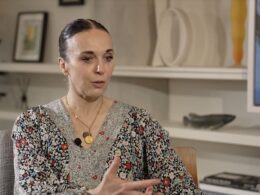More than half of young people watch no traditional broadcast TV at all in a typical week, the media regulator has revealed.
Figures from Ofcom signal the slow demise of live television viewing, with only 48 per cent of 16-to-24-year-olds tuning in to broadcast channels – or even their ‘catch-up’ services – in an average week last year.
This is down dramatically from the 76 per cent of this age group that were watching in this way in 2018.
Ofcom’s Media Nations report found these Gen Z viewers watched just 20 minutes of live TV each day on average.
Instead, the study said this same age group spent more than an hour-and-a-half watching video-sharing platforms such as TikTok and YouTube each day.

Figures from Ofcom signal the slow demise of live television viewing, with only 48 per cent of 16-to-24-year-olds tuning in to broadcast channels (stock image)

Instead, the study said the age group spent more than an hour-and-a-half watching video-sharing platforms such as TikTok and YouTube each day
Children aged between four and 15 were ‘tuning out at a similar rate’ with only 55 per cent of them watching traditional TV each week last year, as compared with 81 per cent in 2018.
Ofcom said younger people were ‘used to swiping and streaming’ rather than ‘flipping through broadcast TV channels’ and liked the ‘flexibility and immediacy’ that on-demand viewing gives.
The report said: ‘For the first time, a quarter of individuals and half of 16-24-year-olds do not watch broadcast TV on a weekly basis.’
Ofcom classifies broadcast TV as the viewing of scheduled ‘linear’ channels on a TV set, but also includes catch-up viewing within 28 days of it being broadcast.
The report also showed that New Year’s Eve Fireworks on BBC One was the most watched show last year, attracting 12.1 million viewers, followed by the final episode of Happy Valley, also with 12.1 million and then BBC One’s coverage of The Coronation of The King and Queen Camilla with 12 million.
Six of the top ten most watched streaming video-on-demand shows in 2023 were films. The most watched show was Chicken Run: Dawn of the Nugget, with an average audience of 7.5 million on Netflix.
It was followed by the animated film Elemental on Disney+ with 6.5 million and the first episode of Netflix’s David Beckham documentary series, which pulled in 5.8 million.
The study makes sober reading for traditional broadcasters as they try to compete with video-sharing platforms and US streaming services like Netflix and Disney+.
The media regulator said the overall proportion of people that were accessing broadcast TV in a week had fallen from 79 per cent in 2022 to 75 per cent last year.

Around 7.5 million viewers watched the climax to Happy Valley, which saw James Norton’s escaped convict Royce set himself ablaze in the kitchen of the embattled officer played by Sarah Lancashire (pictured) – making it one of the most-watched single shows of 2023

King Charles and Queen Camilla sit together and chat in the Gold State Coach as they prepare to set off for Buckingham Palace following their coronation ceremony in May 2023

Viewership among Gen Z was down dramatically from the 76 per cent of this age group that were watching in this way in 2018. Ofcom’s Media Nations report found these Gen Z viewers watched just 20 minutes of live TV each day on average
Research also showed middle-aged viewers (45 to 54) were also starting to desert traditional TV, with those using broadcast TV dropping from 89 per cent to 84 per cent in a single year.
But Ofcom pointed out the ‘enduring importance of linear TV to older audiences’, with 76 per cent of viewing by over-74s done through live TV.
It added that broadcast TV was ‘developing an ever-ageing profile’ with 22 per cent of all broadcast viewing last year by over 75s.
The media regulator did report that daily viewing to the broadcaster’s video-on-demand services, like BBC iPlayer and ITVX, grew by 29 per cent in 2023. But Ofcom said it was not enough to compensate for the decline in viewing on their linear channels.
Despite this decline in traditional viewing, Ofcom said overall people watched more TV and video content at home in 2023, averaging four hours and 31 minutes a day.
It said this was driven by increased viewing to video-sharing platforms such as YouTube and to broadcaster’s on-demand services.
The research also showed that radio is having a major resurgence with its highest amount of weekly listeners in 20 years, with just below 50 million tuning in.
Streaming services saw a small rise in viewing with a six per cent increase last year from the year to 38 minutes per day. The fastest growth is among 55- to 74-year-olds and children, both up by 10 per cent.
Netflix is still the most popular streaming service in the UK, as viewers spend an average of 21 minutes per person per day with the service. It accounts for more than half of subscription video-on-demand viewing.

Netflix is still the most popular streaming service in the UK, as viewers spend an average of 21 minutes per person per day with the service. It accounts for more than half of subscription video-on-demand viewing

Despite this decline in traditional viewing, Ofcom said overall people watched more TV and video content at home in 2023, averaging four hours and 31 minutes a day
But Ofcom revealed that nearly half of adults and teens felt there were too many video-on-demand services and 42 per cent found the amount of available content ‘overwhelming’.
Speaking about the figures, Ian Macrae, Ofcom’s director of market intelligence said: ‘Gen Z and Alpha are used to swiping and streaming, not flipping through broadcast TV channels.
‘They crave the flexibility, immediacy and choice that on-demand services offer, spending over three hours a day watching video, but only 20 minutes of live TV.
‘It’s no surprise that the traditional TV is fast becoming a device of choice to watch YouTube.
‘But while live TV may not have the universal pull it once did, its role in capturing those big moments that bring the nation together remains vital.’
The report said the money being spend on new shows by public service broadcasters, which includes BBC, ITV and Channel 4, was down by more than five per cent.
The media regulator also reported that the spend on ‘physical music formats’ had grown by 10 per cent with growth in spend on vinyl and CD. Buy any hopes of a revival in cassettes seem dashed with sales down by 30 per cent.
It added that 41 per cent of households now own a smartspeaker.










